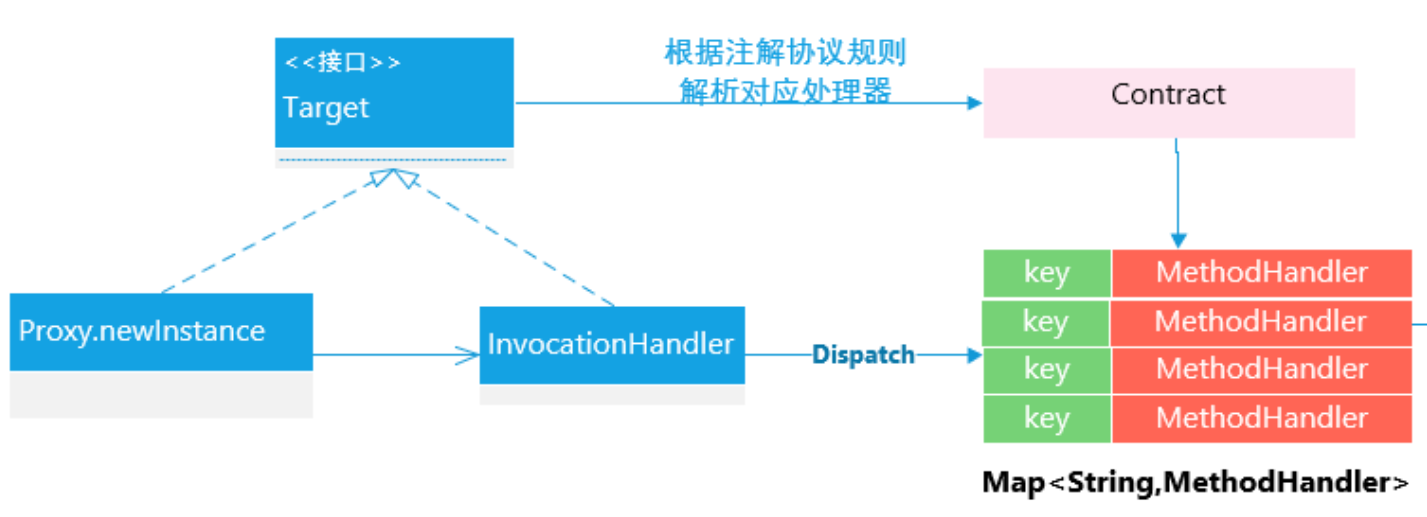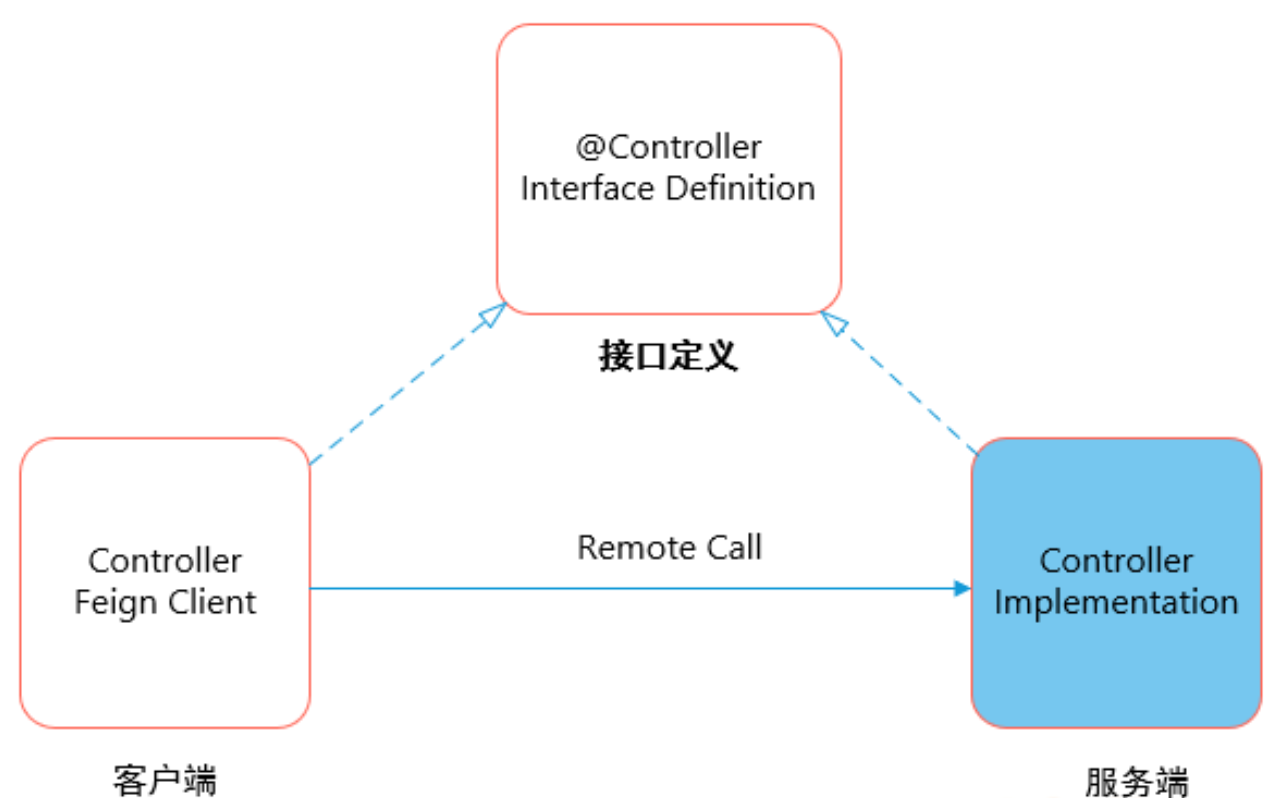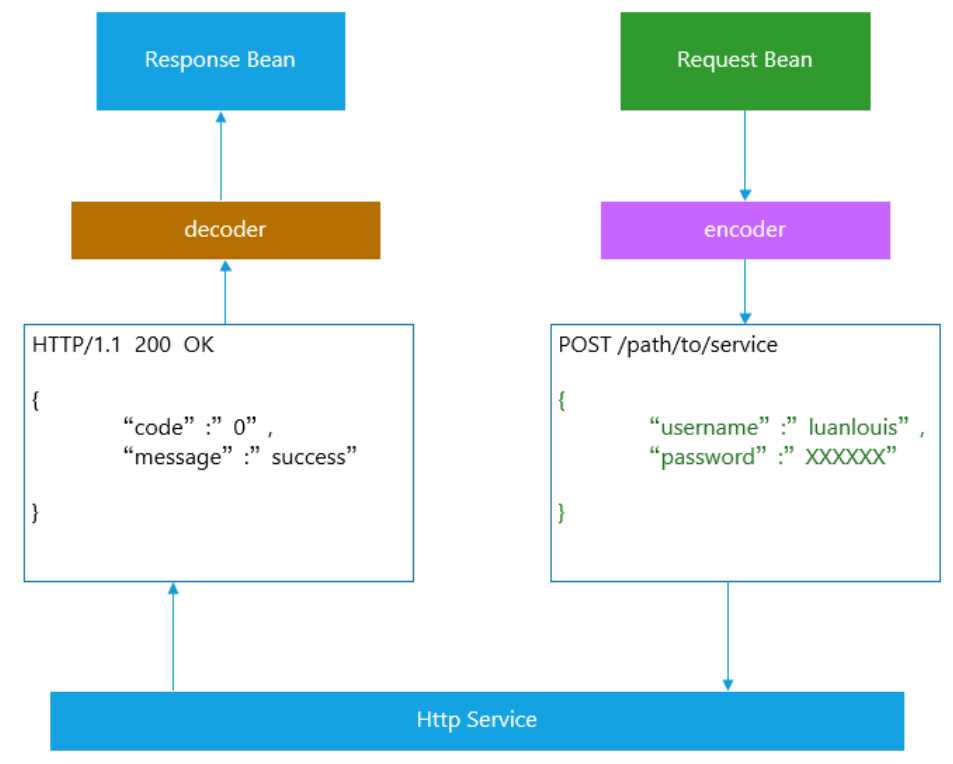什么是Feign?
Feign 的英文表意为“假装,伪装,变形”, 是一个http请求调用的轻量级框架,可以以Java接口注解的方式调用Http请求,而不用像Java中通过封装HTTP请求报文的方式直接调用。Feign通过处理注解,将请求模板化,当实际调用的时候,传入参数,根据参数再应用到请求上,进而转化成真正的请求,这种请求相对而言比较直观。
Feign被广泛应用在Spring Cloud 的解决方案中,是学习基于Spring Cloud 微服务架构不可或缺的重要组件。
开源项目地址:
https://github.com/OpenFeign/feign
Feign解决了什么问题?
封装了Http调用流程,更适合面向接口化的变成习惯
在服务调用的场景中,我们经常调用基于Http协议的服务,而我们经常使用到的框架可能有HttpURLConnection、Apache HttpComponnets、OkHttp3 、Netty等等,这些框架在基于自身的专注点提供了自身特性。而从角色划分上来看,他们的职能是一致的提供Http调用服务。具体流程如下:

Feign是如何设计的?

PHASE 1. 基于面向接口的动态代理方式生成实现类
在使用feign 时,会定义对应的接口类,在接口类上使用Http相关的注解,标识HTTP请求参数信息,如下所示:
interface GitHub { @RequestLine("GET /repos/{owner}/{repo}/contributors") List<Contributor> contributors(@Param("owner") String owner, @Param("repo") String repo); } public static class Contributor { String login; int contributions; } public class MyApp { public static void main(String... args) { GitHub github = Feign.builder() .decoder(new GsonDecoder()) .target(GitHub.class, "https://api.github.com"); // Fetch and print a list of the contributors to this library. List<Contributor> contributors = github.contributors("OpenFeign", "feign"); for (Contributor contributor : contributors) { System.out.println(contributor.login + " (" + contributor.contributions + ")"); } } }
在Feign 底层,通过基于面向接口的动态代理方式生成实现类,将请求调用委托到动态代理实现类,基本原理如下所示:

feign-core包的feign.ReflectiveFeign.java
public class ReflectiveFeign extends Feign{
///省略部分代码
@Override
public <T> T newInstance(Target<T> target) {
//根据接口类和Contract协议解析方式,解析接口类上的方法和注解,转换成内部的MethodHandler处理方式
Map<String, MethodHandler> nameToHandler = targetToHandlersByName.apply(target);
Map<Method, MethodHandler> methodToHandler = new LinkedHashMap<Method, MethodHandler>();
List<DefaultMethodHandler> defaultMethodHandlers = new LinkedList<DefaultMethodHandler>();
for (Method method : target.type().getMethods()) {
if (method.getDeclaringClass() == Object.class) {
continue;
} else if(Util.isDefault(method)) {
DefaultMethodHandler handler = new DefaultMethodHandler(method);
defaultMethodHandlers.add(handler);
methodToHandler.put(method, handler);
} else {
methodToHandler.put(method, nameToHandler.get(Feign.configKey(target.type(), method)));
}
}
InvocationHandler handler = factory.create(target, methodToHandler);
// 基于Proxy.newProxyInstance 为接口类创建动态实现,将所有的请求转换给InvocationHandler 处理。
T proxy = (T) Proxy.newProxyInstance(target.type().getClassLoader(), new Class<?>[]{target.type()}, handler);
for(DefaultMethodHandler defaultMethodHandler : defaultMethodHandlers) {
defaultMethodHandler.bindTo(proxy);
}
return proxy;
}
//省略部分代码
PHASE 2. 根据Contract协议规则,解析接口类的注解信息,解析成内部表现:

Feign 定义了转换协议,定义如下:feign-core包下的feign.Contract.java
/** * Defines what annotations and values are valid on interfaces. */ public interface Contract { /** * Called to parse the methods in the class that are linked to HTTP requests. * 传入接口定义,解析成相应的方法内部元数据表示 * @param targetType {@link feign.Target#type() type} of the Feign interface. */ // TODO: break this and correct spelling at some point List<MethodMetadata> parseAndValidatateMetadata(Class<?> targetType); }
默认Contract 实现
Feign 默认有一套自己的协议规范,规定了一些注解,可以映射成对应的Http请求,如官方的一个例子:
public interface GitHub { @RequestLine("GET /repos/{owner}/{repo}/contributors") List<Contributor> getContributors(@Param("owner") String owner, @Param("repo") String repository); class Contributor { String login; int contributions; } }
上述的例子中,尝试调用GitHub.getContributors("foo","myrepo")的的时候,会转换成如下的HTTP请求:
GET /repos/foo/myrepo/contributors
HOST XXXX.XXX.XXX
Feign 默认的协议规范
| 注解 | 接口Target | 使用说明 |
|---|---|---|
@RequestLine |
方法上 | 定义HttpMethod 和 UriTemplate. UriTemplate 中使用{} 包裹的表达式,可以通过在方法参数上使用@Param 自动注入 |
@Param |
方法参数 | 定义模板变量,模板变量的值可以使用名称的方式使用模板注入解析 |
@Headers |
类上或者方法上 | 定义头部模板变量,使用@Param 注解提供参数值的注入。如果该注解添加在接口类上,则所有的请求都会携带对应的Header信息;如果在方法上,则只会添加到对应的方法请求上 |
@QueryMap |
方法上 | 定义一个键值对或者 pojo,参数值将会被转换成URL上的 query 字符串上 |
@HeaderMap |
方法上 | 定义一个HeaderMap, 与 UrlTemplate 和HeaderTemplate 类型,可以使用@Param 注解提供参数值 |
具体FeignContract 是如何解析的,不在本文的介绍范围内,详情请参考代码:
https://github.com/OpenFeign/feign/blob/master/core/src/main/java/feign/Contract.java
基于Spring MVC的协议规范SpringMvcContract:
当前Spring Cloud 微服务解决方案中,为了降低学习成本,采用了Spring MVC的部分注解来完成 请求协议解析,也就是说 ,写客户端请求接口和像写服务端代码一样:客户端和服务端可以通过SDK的方式进行约定,客户端只需要引入服务端发布的SDK API,就可以使用面向接口的编码方式对接服务:

我们团队内部就是按照这种思路,结合Spring Boot Starter 的特性,定义了服务端starter,
服务消费者在使用的时候,只需要引入Starter,就可以调用服务。这个比较适合平台无关性,接口抽象出来的好处就是可以根据服务调用实现方式自有切换:
- 可以基于简单的Http服务调用;
- 可以基于Spring Cloud 微服务架构调用;
- 可以基于Dubbo SOA服务治理
这种模式比较适合在SaSS混合软件服务的模式下自有切换,根据客户的硬件能力选择合适的方式部署,也可以基于自身的服务集群部署微服务
至于Spring Cloud 是如何实现 协议解析的,可参考代码:
https://github.com/spring-cloud/spring-cloud-openfeign/blob/master/spring-cloud-openfeign-core/src/main/java/org/springframework/cloud/openfeign/support/SpringMvcContract.java
当然,目前的Spring MVC的注解并不是可以完全使用的,有一些注解并不支持,如@GetMapping,@PutMapping 等,仅支持使用@RequestMapping 等,另外注解继承性方面也有些问题;具体限制细节,每个版本能会有些出入,可以参考上述的代码实现,比较简单。
Spring Cloud 没有基于Spring MVC 全部注解来做Feign 客户端注解协议解析,个人认为这个是一个不小的坑。在刚入手Spring Cloud 的时候,就碰到这个问题。后来是深入代码才解决的.... 这个应该有人写了增强类来处理,暂且不表,先MARK一下,是一个开源代码练手的好机会。
PHASE 3. 基于 RequestBean,动态生成Request
根据传入的Bean对象和注解信息,从中提取出相应的值,来构造Http Request 对象:

PHASE 4. 使用Encoder 将Bean转换成 Http报文正文(消息解析和转码逻辑)
Feign 最终会将请求转换成Http 消息发送出去,传入的请求对象最终会解析成消息体,如下所示:

在接口定义上Feign做的比较简单,抽象出了Encoder 和decoder 接口:
public interface Encoder { /** Type literal for {@code Map<String, ?>}, indicating the object to encode is a form. */ Type MAP_STRING_WILDCARD = Util.MAP_STRING_WILDCARD; /** * Converts objects to an appropriate representation in the template. * 将实体对象转换成Http请求的消息正文中 * @param object what to encode as the request body. * @param bodyType the type the object should be encoded as. {@link #MAP_STRING_WILDCARD} * indicates form encoding. * @param template the request template to populate. * @throws EncodeException when encoding failed due to a checked exception. */ void encode(Object object, Type bodyType, RequestTemplate template) throws EncodeException; /** * Default implementation of {@code Encoder}. */ class Default implements Encoder { @Override public void encode(Object object, Type bodyType, RequestTemplate template) { if (bodyType == String.class) { template.body(object.toString()); } else if (bodyType == byte[].class) { template.body((byte[]) object, null); } else if (object != null) { throw new EncodeException( format("%s is not a type supported by this encoder.", object.getClass())); } } } } public interface Decoder { /** * Decodes an http response into an object corresponding to its {@link * java.lang.reflect.Method#getGenericReturnType() generic return type}. If you need to wrap * exceptions, please do so via {@link DecodeException}. * 从Response 中提取Http消息正文,通过接口类声明的返回类型,消息自动装配 * @param response the response to decode * @param type {@link java.lang.reflect.Method#getGenericReturnType() generic return type} of * the method corresponding to this {@code response}. * @return instance of {@code type} * @throws IOException will be propagated safely to the caller. * @throws DecodeException when decoding failed due to a checked exception besides IOException. * @throws FeignException when decoding succeeds, but conveys the operation failed. */ Object decode(Response response, Type type) throws IOException, DecodeException, FeignException; /** Default implementation of {@code Decoder}. */ public class Default extends StringDecoder { @Override public Object decode(Response response, Type type) throws IOException { if (response.status() == 404) return Util.emptyValueOf(type); if (response.body() == null) return null; if (byte[].class.equals(type)) { return Util.toByteArray(response.body().asInputStream()); } return super.decode(response, type); } } }
目前Feign 有以下实现:
| Encoder/ Decoder 实现 | 说明 |
|---|---|
| JacksonEncoder,JacksonDecoder | 基于 Jackson 格式的持久化转换协议 |
| GsonEncoder,GsonDecoder | 基于Google GSON 格式的持久化转换协议 |
| SaxEncoder,SaxDecoder | 基于XML 格式的Sax 库持久化转换协议 |
| JAXBEncoder,JAXBDecoder | 基于XML 格式的JAXB 库持久化转换协议 |
| ResponseEntityEncoder,ResponseEntityDecoder | Spring MVC 基于 ResponseEntity< T > 返回格式的转换协议 |
| SpringEncoder,SpringDecoder | 基于Spring MVC HttpMessageConverters 一套机制实现的转换协议 ,应用于Spring Cloud 体系中 |
PHASE 5. 拦截器负责对请求和返回进行装饰处理
在请求转换的过程中,Feign 抽象出来了拦截器接口,用于用户自定义对请求的操作:
public interface RequestInterceptor { /** * 可以在构造RequestTemplate 请求时,增加或者修改Header, Method, Body 等信息 * Called for every request. Add data using methods on the supplied {@link RequestTemplate}. */ void apply(RequestTemplate template); }
比如,如果希望Http消息传递过程中被压缩,可以定义一个请求拦截器:
public class FeignAcceptGzipEncodingInterceptor extends BaseRequestInterceptor { /** * Creates new instance of {@link FeignAcceptGzipEncodingInterceptor}. * * @param properties the encoding properties */ protected FeignAcceptGzipEncodingInterceptor(FeignClientEncodingProperties properties) { super(properties); } /** * {@inheritDoc} */ @Override public void apply(RequestTemplate template) { // 在Header 头部添加相应的数据信息 addHeader(template, HttpEncoding.ACCEPT_ENCODING_HEADER, HttpEncoding.GZIP_ENCODING, HttpEncoding.DEFLATE_ENCODING); } }
PHASE 6. 日志记录
在发送和接收请求的时候,Feign定义了统一的日志门面来输出日志信息 , 并且将日志的输出定义了四个等级:
| 级别 | 说明 |
|---|---|
| NONE | 不做任何记录 |
| BASIC | 只记录输出Http 方法名称、请求URL、返回状态码和执行时间 |
| HEADERS | 记录输出Http 方法名称、请求URL、返回状态码和执行时间 和 Header 信息 |
| FULL | 记录Request 和Response的Header,Body和一些请求元数据 |
public abstract class Logger { protected static String methodTag(String configKey) { return new StringBuilder().append('[').append(configKey.substring(0, configKey.indexOf('('))) .append("] ").toString(); } /** * Override to log requests and responses using your own implementation. Messages will be http * request and response text. * * @param configKey value of {@link Feign#configKey(Class, java.lang.reflect.Method)} * @param format {@link java.util.Formatter format string} * @param args arguments applied to {@code format} */ protected abstract void log(String configKey, String format, Object... args); protected void logRequest(String configKey, Level logLevel, Request request) { log(configKey, "---> %s %s HTTP/1.1", request.method(), request.url()); if (logLevel.ordinal() >= Level.HEADERS.ordinal()) { for (String field : request.headers().keySet()) { for (String value : valuesOrEmpty(request.headers(), field)) { log(configKey, "%s: %s", field, value); } } int bodyLength = 0; if (request.body() != null) { bodyLength = request.body().length; if (logLevel.ordinal() >= Level.FULL.ordinal()) { String bodyText = request.charset() != null ? new String(request.body(), request.charset()) : null; log(configKey, ""); // CRLF log(configKey, "%s", bodyText != null ? bodyText : "Binary data"); } } log(configKey, "---> END HTTP (%s-byte body)", bodyLength); } } protected void logRetry(String configKey, Level logLevel) { log(configKey, "---> RETRYING"); } protected Response logAndRebufferResponse(String configKey, Level logLevel, Response response, long elapsedTime) throws IOException { String reason = response.reason() != null && logLevel.compareTo(Level.NONE) > 0 ? " " + response.reason() : ""; int status = response.status(); log(configKey, "<--- HTTP/1.1 %s%s (%sms)", status, reason, elapsedTime); if (logLevel.ordinal() >= Level.HEADERS.ordinal()) { for (String field : response.headers().keySet()) { for (String value : valuesOrEmpty(response.headers(), field)) { log(configKey, "%s: %s", field, value); } } int bodyLength = 0; if (response.body() != null && !(status == 204 || status == 205)) { // HTTP 204 No Content "...response MUST NOT include a message-body" // HTTP 205 Reset Content "...response MUST NOT include an entity" if (logLevel.ordinal() >= Level.FULL.ordinal()) { log(configKey, ""); // CRLF } byte[] bodyData = Util.toByteArray(response.body().asInputStream()); bodyLength = bodyData.length; if (logLevel.ordinal() >= Level.FULL.ordinal() && bodyLength > 0) { log(configKey, "%s", decodeOrDefault(bodyData, UTF_8, "Binary data")); } log(configKey, "<--- END HTTP (%s-byte body)", bodyLength); return response.toBuilder().body(bodyData).build(); } else { log(configKey, "<--- END HTTP (%s-byte body)", bodyLength); } } return response; } protected IOException logIOException(String configKey, Level logLevel, IOException ioe, long elapsedTime) { log(configKey, "<--- ERROR %s: %s (%sms)", ioe.getClass().getSimpleName(), ioe.getMessage(), elapsedTime); if (logLevel.ordinal() >= Level.FULL.ordinal()) { StringWriter sw = new StringWriter(); ioe.printStackTrace(new PrintWriter(sw)); log(configKey, sw.toString()); log(configKey, "<--- END ERROR"); } return ioe; }
PHASE 7 . 基于重试器发送HTTP请求
Feign 内置了一个重试器,当HTTP请求出现IO异常时,Feign会有一个最大尝试次数发送请求,以下是Feign核心
代码逻辑:
feign-core包下的feign.SynchronousMethodHandler.java
final class SynchronousMethodHandler implements MethodHandler { // 省略部分代码 @Override public Object invoke(Object[] argv) throws Throwable { //根据输入参数,构造Http 请求。 RequestTemplate template = buildTemplateFromArgs.create(argv); // 克隆出一份重试器 Retryer retryer = this.retryer.clone(); // 尝试最大次数,如果中间有结果,直接返回 while (true) { try { return executeAndDecode(template); } catch (RetryableException e) { retryer.continueOrPropagate(e); if (logLevel != Logger.Level.NONE) { logger.logRetry(metadata.configKey(), logLevel); } continue; } } }
重试器有如下几个控制参数:
| 重试参数 | 说明 | 默认值 |
|---|---|---|
| period | 初始重试时间间隔,当请求失败后,重试器将会暂停 初始时间间隔(线程 sleep 的方式)后再开始,避免强刷请求,浪费性能 | 100ms |
| maxPeriod | 当请求连续失败时,重试的时间间隔将按照:long interval = (long) (period * Math.pow(1.5, attempt - 1)); 计算,按照等比例方式延长,但是最大间隔时间为 maxPeriod, 设置此值能够避免 重试次数过多的情况下执行周期太长 |
1000ms |
| maxAttempts | 最大重试次数 | 5 |
具体的代码实现可参考:
https://github.com/OpenFeign/feign/blob/master/core/src/main/java/feign/Retryer.java
PHASE 8. 发送Http请求
Feign 真正发送HTTP请求是委托给 feign.Client 来做的:
public interface Client { /** * Executes a request against its {@link Request#url() url} and returns a response. * 执行Http请求,并返回Response * @param request safe to replay. * @param options options to apply to this request. * @return connected response, {@link Response.Body} is absent or unread. * @throws IOException on a network error connecting to {@link Request#url()}. */ Response execute(Request request, Options options) throws IOException; }
Feign 默认底层通过JDK 的 java.net.HttpURLConnection 实现了feign.Client接口类,在每次发送请求的时候,都会创建新的HttpURLConnection 链接,这也就是为什么默认情况下Feign的性能很差的原因。可以通过拓展该接口,使用Apache HttpClient 或者OkHttp3等基于连接池的高性能Http客户端,我们项目内部使用的就是OkHttp3作为Http 客户端。
1 Feign 的默认实现
如下是Feign 的默认实现,供参考:
public static class Default implements Client { private final SSLSocketFactory sslContextFactory; private final HostnameVerifier hostnameVerifier; /** * Null parameters imply platform defaults. */ public Default(SSLSocketFactory sslContextFactory, HostnameVerifier hostnameVerifier) { this.sslContextFactory = sslContextFactory; this.hostnameVerifier = hostnameVerifier; } @Override public Response execute(Request request, Options options) throws IOException { HttpURLConnection connection = convertAndSend(request, options); return convertResponse(connection).toBuilder().request(request).build(); } HttpURLConnection convertAndSend(Request request, Options options) throws IOException { final HttpURLConnection connection = (HttpURLConnection) new URL(request.url()).openConnection(); if (connection instanceof HttpsURLConnection) { HttpsURLConnection sslCon = (HttpsURLConnection) connection; if (sslContextFactory != null) { sslCon.setSSLSocketFactory(sslContextFactory); } if (hostnameVerifier != null) { sslCon.setHostnameVerifier(hostnameVerifier); } } connection.setConnectTimeout(options.connectTimeoutMillis()); connection.setReadTimeout(options.readTimeoutMillis()); connection.setAllowUserInteraction(false); connection.setInstanceFollowRedirects(true); connection.setRequestMethod(request.method()); Collection<String> contentEncodingValues = request.headers().get(CONTENT_ENCODING); boolean gzipEncodedRequest = contentEncodingValues != null && contentEncodingValues.contains(ENCODING_GZIP); boolean deflateEncodedRequest = contentEncodingValues != null && contentEncodingValues.contains(ENCODING_DEFLATE); boolean hasAcceptHeader = false; Integer contentLength = null; for (String field : request.headers().keySet()) { if (field.equalsIgnoreCase("Accept")) { hasAcceptHeader = true; } for (String value : request.headers().get(field)) { if (field.equals(CONTENT_LENGTH)) { if (!gzipEncodedRequest && !deflateEncodedRequest) { contentLength = Integer.valueOf(value); connection.addRequestProperty(field, value); } } else { connection.addRequestProperty(field, value); } } } // Some servers choke on the default accept string. if (!hasAcceptHeader) { connection.addRequestProperty("Accept", "*/*"); } if (request.body() != null) { if (contentLength != null) { connection.setFixedLengthStreamingMode(contentLength); } else { connection.setChunkedStreamingMode(8196); } connection.setDoOutput(true); OutputStream out = connection.getOutputStream(); if (gzipEncodedRequest) { out = new GZIPOutputStream(out); } else if (deflateEncodedRequest) { out = new DeflaterOutputStream(out); } try { out.write(request.body()); } finally { try { out.close(); } catch (IOException suppressed) { // NOPMD } } } return connection; } Response convertResponse(HttpURLConnection connection) throws IOException { int status = connection.getResponseCode(); String reason = connection.getResponseMessage(); if (status < 0) { throw new IOException(format("Invalid status(%s) executing %s %s", status, connection.getRequestMethod(), connection.getURL())); } Map<String, Collection<String>> headers = new LinkedHashMap<String, Collection<String>>(); for (Map.Entry<String, List<String>> field : connection.getHeaderFields().entrySet()) { // response message if (field.getKey() != null) { headers.put(field.getKey(), field.getValue()); } } Integer length = connection.getContentLength(); if (length == -1) { length = null; } InputStream stream; if (status >= 400) { stream = connection.getErrorStream(); } else { stream = connection.getInputStream(); } return Response.builder() .status(status) .reason(reason) .headers(headers) .body(stream, length) .build(); } }
2 Feign-使用HttpClient和OkHttp
那么如何在Feign中使用HttpClient的框架呢?我们查看FeignAutoConfiguration.HttpClientFeignConfiguration的源码:
spring-cloud-netflix-core包中的org.springframework.cloud.netflix.feign.FeignAutoConfiguration.java
@Configuration @ConditionalOnClass(ApacheHttpClient.class) @ConditionalOnMissingClass("com.netflix.loadbalancer.ILoadBalancer") @ConditionalOnMissingBean(CloseableHttpClient.class) @ConditionalOnProperty(value = "feign.httpclient.enabled", matchIfMissing = true) protected static class HttpClientFeignConfiguration { //... }
从代码@ConditionalOnClass({ApacheHttpClient.class})注解可知,只需要在pom文件上加上HttpClient依赖即可。另外需要在配置文件中配置feign.httpclient.enabled为true,从@ConditionalOnProperty注解可知,这个配置可以不写,因为在默认情况下就为true:
<dependency>
<groupId>io.github.openfeign</groupId>
<artifactId>feign-httpclient</artifactId>
<version>9.4.0</version>
</dependency>
使用OkHttp
查看FeignAutoConfiguration.HttpClientFeignConfiguration的源码:
@Configuration @ConditionalOnClass(OkHttpClient.class) @ConditionalOnMissingClass("com.netflix.loadbalancer.ILoadBalancer") @ConditionalOnMissingBean(okhttp3.OkHttpClient.class) @ConditionalOnProperty(value = "feign.okhttp.enabled") protected static class OkHttpFeignConfiguration { private okhttp3.OkHttpClient okHttpClient; //... }
同理,如果想要在Feign中使用OkHttp作为网络请求框架,则只需要在pom文件中加上feign-okhttp的依赖,代码如下:
<dependency>
<groupId>io.github.openfeign</groupId>
<artifactId>feign-okhttp</artifactId>
<version>10.2.0</version>
</dependency>
Feign 的性能怎么样?
Feign 整体框架非常小巧,在处理请求转换和消息解析的过程中,基本上没什么时间消耗。真正影响性能的,是处理Http请求的环节。
如上所述,由于默认情况下,Feign采用的是JDK的HttpURLConnection,所以整体性能并不高,刚开始接触Spring Cloud 的同学,如果没注意这些细节,可能会对Spring Cloud 有很大的偏见。
我们项目内部使用的是OkHttp3 作为连接客户端。